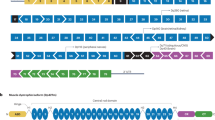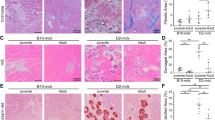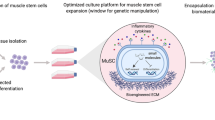Abstract
Arising from: M. Sampaolesi et al. Nature 444, 574–579 (2006)10.1038/nature05282; Sampaolesi et al. reply
Human muscular dystrophies are devastating and incurable inherited diseases. Hopes of progress towards therapy of muscular dystrophies were aroused when Sampaolesi et al.1 reported “extensive recovery of dystrophin expression, normal muscle...function”, and “remarkable clinical amelioration” in golden retriever muscular dystrophy dogs treated with ‘mesoangioblasts’. Here I re-examine their results, showing how their assessments might be flawed and their conclusions overstated. Further studies will be required to evaluate fully the clinical potential of this work.
Similar content being viewed by others
Main
My first concern is that control and test dogs were not matched for disease characteristics at the start of treatment to avoid inadvertently biased groupings in small experimental cohorts, where extensive individual variations exist. Also, the authors’ evaluations were not blinded. For example, their Supplementary Videos1 seem to show greater human encouragement of treated compared with untreated dogs, so functional recovery may not be independently verifiable by viewers, especially the “striking improvement of motility” in the older dogs treated with mesoangioblasts.
Second, Fig. 5a of Sampaolesi et al.1 indicates that muscle strength declined, rather than was maintained as they imply, in the treated legs of all dystrophic dogs in which it was assessed. At later time points, strength was always less than at 5 months. Between the ages of 5 and 9 months, the averaged decline in strength of the two older treated dogs was ∼40% (∼0.079 to ∼0.048 kg-1 (%)), even more than the ∼25% decline in the control untreated dystrophic dog over the same period. Against this real ∼40% decline, purported improvements of ∼50% and ∼80% in treated leg-muscle strength relative to contralateral, untreated muscles of these two dogs (Fig. 5b of Sampaolesi et al.1) are misleading and probably explained by simultaneous declines in contralateral muscle strength of ∼60% and ∼67%, respectively.
Third, the dogs Valgus, Varus and Vaccin each received 5 × 107 mesoangioblasts per treatment, but these were infused into the aortic arch of Valgus and the left femoral artery of the others. At biopsy, ∼30–70% of fibres in sections of Valgus’ left sartorius and gastrocnemius muscles appeared to be dystrophin-positive (Fig. 4a of Sampaolesi et al.1), whereas the equivalent dystrophin-positive proportion of Varus’ left sartorius was ∼0–10%, and that of Vaccin’s left gastrocnemius was only 0–5%. Numbers of mesoangioblasts reaching the lower left leg from upper aortic infusion, after major systemic blood diversions2, should have been ∼10 times less than from direct femoral infusion. However, no assessed muscles of Valgus had fewer—and certainly not 10 times fewer—dystrophin-positive fibres than corresponding muscles of Varus or Vaccin. Moreover, some of the untreated muscles of Varus and Vaccin revealed up to 50% dystrophin-positive fibres (Fig. 4a of Sampaolesi et al.1).
Minimal mesoangioblast recirculation3 cannot easily explain these anomalies, whereas dystrophin-positive fibres in both treated and untreated muscles might represent false positives or revertants4, rather than evidence of mesoangioblast engraftment. Control biopsies from pre-treatment and untreated dystrophic dogs4 would have allowed these possibilities to be differentiated. Alternatively, if recirculation and engraftment is responsible for similar percentages of dystrophin-positive fibres in treated and ‘untreated’ tibialis cranialis muscles (Fig. 4a of Sampaolesi et al.1), then contrasting their strengths (Fig. 5b of Sampaolesi et al.1) is unfounded.
There is an indicator of benefit arising from this trial, although it is, perhaps, due to concurrent immunosuppression rather than to mesoangioblasts. Supplementary Fig. 7 of Sampaolesi et al.1 shows that levels of the muscle-breakdown marker serum creatine kinase decreased markedly soon after initiating immunosuppression (as previously seen in mdx mice5) and before injection of heterologous mesoangioblasts, whereas in the days immediately after mesoangioblast injection, creatine kinase levels varied randomly, decreasing substantially (>5,000 U) in three instances but increasing in five. This does not support the authors’ hypothesis that creatine kinase reductions demonstrate mesoangioblast reconstitution of muscle fibres.
Control dystrophic dogs lived, on average, 129 days longer than six out of ten treated dogs (123 days longer than those treated with autologous mesoangioblasts). Three of the four remaining treated dogs, described as “well” 400 days post natal, “rapidly lost walking ability” when immunosuppression ceased (257 days post natal for two of these).
Altogether, the evidence presented by Sampaolesi et al.1 does not convince me that the dogs benefited from mesoangioblast treatment; a rigorous demonstration correlating muscle function, dystrophin expression and mesoangioblast infusion, with adequate controls, would have been helpful in this regard. It is therefore premature to consider a clinical trial in humans as a justifiable extension of this study.
References
Sampaolesi, M. et al. Mesoangioblast stem cells ameliorate muscle function in dystrophic dogs. Nature 444, 574–579 (2006)
Guyton, A. C. Textbook of Medical Physiology 7th edn 230 (Saunders, Philadelphia, 1986)
Galvez, B. G. et al. Complete repair of dystrophic skeletal muscle by mesoangioblasts with enhanced migration ability. J. Cell Biol. 174, 231–243 (2006)
Dell’Agnola, C. et al. Hematopoietic stem cell transplantation does not restore dystrophin expression in Duchenne muscular dystrophy dogs. Blood 104, 4311–4318 (2004)
De Luca, A. et al. A multidisciplinary evaluation of the effectiveness of cyclosporine A in dystrophic mdx mice. Am. J. Pathol. 166, 477–489 (2005)
Author information
Authors and Affiliations
Rights and permissions
About this article
Cite this article
Bretag, A. Stem cell treatment of dystrophic dogs. Nature 450, E23 (2007). https://doi.org/10.1038/nature06437
Received:
Accepted:
Issue Date:
DOI: https://doi.org/10.1038/nature06437
This article is cited by
-
Muscle and cardiac therapeutic strategies for Duchenne muscular dystrophy: past, present, and future
Pharmacological Reports (2020)
-
Canine models of Duchenne muscular dystrophy and their use in therapeutic strategies
Mammalian Genome (2012)
-
Dystrophy patients' muscle stem cells treat mice
Nature Reports Stem Cells (2008)
-
Sampaolesi et al. reply
Nature (2007)
Comments
By submitting a comment you agree to abide by our Terms and Community Guidelines. If you find something abusive or that does not comply with our terms or guidelines please flag it as inappropriate.



